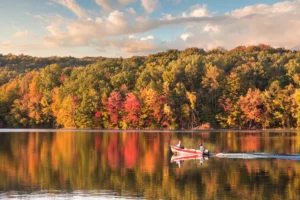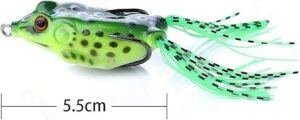Fall Bass Fishing Techniques

Seasonal changes bring a unique challenge to anglers, and bass behavior during fall can be particularly intriguing. As water temperatures begin to drop, bass respond by altering their patterns and habits. Understanding these changes is key to successful fishing.
One major factor is water temperature. As the weather cools, bass find comfort in warmer, deeper waters. This shift requires anglers to adapt their approach, focusing on areas where the sun’s warmth is retained longer or where water circulates less, maintaining higher temperatures.
Daylight plays another important role. Bass are affected by the shortening days, which influence feeding and movement patterns. During fall, bass eating habits become more aggressive as they prepare for winter, making them more likely to go after larger prey. This is why understanding the timing of light and shadows can help pinpoint the best fishing times.
Barometric pressure variations can also cause bass to change locations. Many feel a change in pressure triggers movement, so keeping an eye on weather forecasts can be a game changer. A drop in pressure might signal a feeding frenzy, ideal for catching those elusive fish.
Finally, knowing where bass tend to congregate in the fall is crucial. Look for structures like logs, docks, or vegetation – any area that offers cover and retains a bit of warmth. Bass are prone to stay near these areas, which provide both protection and the opportunity to ambush unsuspecting prey.
Essential Gear for Fall Bass Fishing
Success in fall bass fishing often hinges on having the right gear. The transition to fall conditions means adjusting your tackle and equipment to match the changing environment and bass behavior.
Choosing the right rod and reel combination is crucial. In the fall, you might encounter more aggressive bass, so a medium-heavy rod paired with a high-speed reel can offer the necessary power and sensitivity. This setup allows swift responses to quick strikes and helps in managing larger catches.
Lures and baits play a significant role in enticing bass during these months. During fall, bass are often in a feeding frenzy to prepare for the colder months, so selecting the right lure is key. Jerkbaits and crankbaits that resemble the baitfish bass are hunting can be very effective. Don’t overlook spinnerbaits and swimbaits either, as their movement can trigger reactions from lurking bass.
Effective storage solutions, like a well-organized tackle box, keep various lures and tools within easy reach, minimizing time spent searching when you could be fishing. Understanding when and how to switch out lures based on water conditions and bass activity can improve your success rate.
Line choice can impact your results significantly as well. Braided lines provide strength and sensitivity needed for fall fishing, but fluorocarbon lines offer a stealthier approach when dealing with clearer waters.
Following these tips and ensuring your gear is tailored for fall conditions can enhance your chances of landing that prized bass. With the right equipment in hand, focusing on the nuances of fall behavior and adapting to them becomes much easier.
Effective Techniques and Strategies for Catching Fall Bass
Using the right techniques can elevate your bass fishing experience during the fall transition. There are some tried-and-true strategies that capitalize on the bass’s changing habits.
Topwater vs. deepwater tactics offer a fascinating choice. As the season progresses, topwater lures can still be exciting to use early in the morning or late in the afternoon. However, dipping into deeper waters later in the season becomes essential as bass move deeper seeking stable conditions.
Finesse techniques come into play when conditions get tricky. Sometimes bass are finicky, so opting for lighter lines and smaller baits can persuade them to bite when other methods fail. Drop shots and shaky heads can be particularly effective in coaxing a reluctant bass.
Jerkbait and crankbait methods are also fantastic for targeting active bass. When you’re aware that bass are aggressively feeding, these lures can mimic the quick movements of fleeing baitfish, making them irresistible. Adjust your retrieve speed to match the activity level of the bass, slowing down when they seem less energetic.
Spinnerbaits and swimbaits bring a different advantage; their ability to cover more water and draw attention can be vital when bass are dispersed. These lures work well over flats or near ledges where bass might be hiding.
Successfully catching fall bass often involves careful timing and positioning. Pay attention to the shadows and fish movement during different times of the day. Understanding these patterns can lead to more successful catches and fulfilling fishing trips.
Best Locations for Fall Bass Fishing
Identifying where to fish during fall is crucial, as bass shift their locations to adapt to the changing environment. Knowing the best places to cast your line can dramatically enhance your success.
Lakes, rivers, and reservoirs all hold potential, but each offers different conditions. Lakes can offer great structure and cover spots. As water cools, focus on shallow rocks and weedy areas. Rivers, with their flowing waters, often keep bass active longer, and you might find them near eddies or bends where food collects. Reservoirs frequently see bass move toward dam faces or creek channels.
Water clarity and oxygen levels also play a part. Clear waters mean bass can spot lures from a distance, calling for a stealthier approach, while murkier waters may allow for bolder presentations. Areas with good oxygen flow, such as near waterfalls or currents, are prime spots, as bass prefer these environments.
Reading maps and using fish finders can be vital tools. A good map can highlight those hidden structures where bass might congregate, and a fish finder can reveal the depth and activity level of fish, guiding your strategy for the day.
Lastly, understanding how to differentiate between public and private waters and knowing the regulations on each is key. Public spots can be competitive with more anglers, requiring precise timing or techniques, while private waters may provide less competition but still necessitate permission or fees.
Safety and Conservation Tips for Fall Bass Fishing
Ensuring safety during your fall fishing trips should always be a top priority. Dressing appropriately for cooler fall temperatures can make a big difference, especially if you’re out early in the morning or as the sun sets. Layering with weather-resistant clothing ensures you stay warm and dry, reducing the risk of hypothermia.
Wearing a life jacket while on the water, especially when fishing solo or in unfamiliar locations, is another essential safety measure. Accidents happen, and having a life jacket can be lifesaving.
Practicing catch-and-release techniques not only helps sustain the bass population but also contributes to the health of aquatic ecosystems. Using barbless hooks and handling fish gently ensures they can be released back with minimal harm.
Maintaining clean fishing environments shows respect for nature and ensures the same spots can be enjoyed by future anglers. Make it a habit to dispose of any trash or fishing lines properly, and consider participating in local cleanup events.
Involvement in community conservation efforts can be rewarding. By volunteering for habitat restoration projects or supporting organizations dedicated to protecting aquatic environments, you contribute to preserving fishing opportunities for generations to come.


